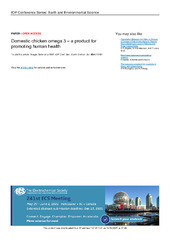Prikaz osnovnih podataka o dokumentu
Domestic chicken omega 3 – a product for promoting human health
| dc.creator | Šefer, Dragan | |
| dc.creator | Radulović, Stamen | |
| dc.creator | Perić, Dejan | |
| dc.creator | Čefer, Matija | |
| dc.creator | Makivić, Lazar | |
| dc.creator | Grdović, Svetlana | |
| dc.creator | Marković, Radmila | |
| dc.date.accessioned | 2021-12-16T07:53:53Z | |
| dc.date.available | 2021-12-16T07:53:53Z | |
| dc.date.issued | 2021 | |
| dc.identifier.issn | 1755-1315 | |
| dc.identifier.uri | https://vet-erinar.vet.bg.ac.rs/handle/123456789/2291 | |
| dc.description.abstract | Literature data show that the relationship between two groups of polyunsaturated fatty acids in diet, omega 3 acids, whose basic representative is a-linolenic acid (C18: 3 n-3), and omega 6 acids, whose basic representative is linoleic acid (C18: 2 n-6), has a significant role in development of cardiovascular diseases in humans. The optimal ratio of omega 6 to omega 3 fatty acids is around 4:1. In monogastric animals, the fatty acids in feed are absorbed in the gastrointestinal tract largely unchanged. This means the fatty acid profile of the animal’s diet directly reflects the fatty acid profile of the tissue. The daily intake of unsaturated fatty acids can be increased by an adequate animal nutrition strategy. Flaxseed contains ten times more unsaturated (32.26%) than saturated (3.66%) fatty acids. The largest amount of unsaturated fatty acids (about 70%) is a-linolenic acid (ALA), which is a precursor of the entire omega 3 series of fatty acids, and which makes flaxseed an ideal raw material for the production of a wide range of omega 3 enriched products. In order to obtain chicken meat rich in omega 3, an experiment was organized with a specific diet for broilers at fattening. Thanks to the designed animal feed, it was possible to get products (meat, breast, drumstick, liver, subcutaneous fat) with significantly higher amounts of omega 3 fatty acids compared to the same products obtained from broilers fed with conventional mixtures, or with almost the ideal ratio between omega 6 and omega 3 fatty acids. | |
| dc.language | en | |
| dc.publisher | IOP Publishing Ltd | |
| dc.relation | info:eu-repo/grantAgreement/MESTD/inst-2020/200143/RS// | |
| dc.rights | openAccess | |
| dc.rights.uri | https://creativecommons.org/licenses/by/4.0/ | |
| dc.source | IOP Conference Series: Earth and Environmental Science | |
| dc.source | IOP Conference Series: Earth and Environmental Science | |
| dc.subject | Domestic chicken | |
| dc.subject | omega 3 | |
| dc.subject | promoting human health | |
| dc.title | Domestic chicken omega 3 – a product for promoting human health | |
| dc.type | conferenceObject | en |
| dc.rights.license | BY | |
| dc.citation.volume | 854 | |
| dc.citation.issue | 1 | |
| dc.citation.spage | 012081 | |
| dc.identifier.doi | 10.1088/1755-1315/854/1/012081 | |
| dc.identifier.scopus | 2-s2.0-85120417588 | |
| dc.identifier.fulltext | http://veterinar.vet.bg.ac.rs/bitstream/id/6337/Sefer_2021_IOP.pdf | |
| dc.type.version | publishedVersion |

